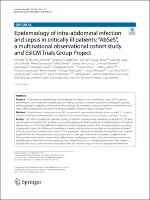Epidemiology of intra-abdominal infection and sepsis in critically ill patients: “AbSeS”, a multinational observational cohort study and ESICM Trials Group Project

View
Author
Date
2019-10-29Permanent link
https://hdl.handle.net/11351/5205DOI
10.1007/s00134-019-05819-3
ISSN
0342-4642
WOS
000493268200001
PMID
31664501
Abstract
Purpose: To describe the epidemiology of intra-abdominal infection in an international cohort of ICU patients according to a new system that classifies cases according to setting of infection acquisition (community-acquired, early onset hospital-acquired, and late-onset hospital-acquired), anatomical disruption (absent or present with localized or diffuse peritonitis), and severity of disease expression (infection, sepsis, and septic shock). Methods: We performed a multicenter (n = 309), observational, epidemiological study including adult ICU patients diagnosed with intra-abdominal infection. Risk factors for mortality were assessed by logistic regression analysis. Results: The cohort included 2621 patients. Setting of infection acquisition was community-acquired in 31.6%, early onset hospital-acquired in 25%, and late-onset hospital-acquired in 43.4% of patients. Overall prevalence of antimicrobial resistance was 26.3% and difficult-to-treat resistant Gram-negative bacteria 4.3%, with great variation according to geographic region. No difference in prevalence of antimicrobial resistance was observed according to setting of
infection acquisition. Overall mortality was 29.1%. Independent risk factors for mortality included late-onset hospitalacquired infection, diffuse peritonitis, sepsis, septic shock, older age, malnutrition, liver failure, congestive heart failure, antimicrobial resistance (either methicillin-resistant Staphylococcus aureus, vancomycin-resistant enterococci, extended-spectrum beta-lactamase-producing Gram-negative bacteria, or carbapenem-resistant Gram-negative bacteria) and source control failure evidenced by either the need for surgical revision or persistent inflammation. Conclusion: This multinational, heterogeneous cohort of ICU patients with intra-abdominal infection revealed that setting of infection acquisition, anatomical disruption, and severity of disease expression are disease-specific phenotypic characteristics associated with outcome, irrespective of the type of infection. Antimicrobial resistance is equally common in community-acquired as in hospital-acquired infection.
Keywords
Intra-abdominal infection; Peritonitis; SepsisBibliographic citation
Blot S, Antonelli M, Arvaniti K, Blot K, Creagh-Brown B, de Lange D, et al. Epidemiology of intra-abdominal infection and sepsis in critically ill patients: “AbSeS”, a multinational observational cohort study and ESICM Trials Group Project. Intensive Care Med. 2019 Oct 29;45(12):1703–17.
Audience
Professionals
This item appears in following collections
- VHIR - Articles científics [1751]
The following license files are associated with this item:

 Private area
Private area Contact Us
Contact Us







